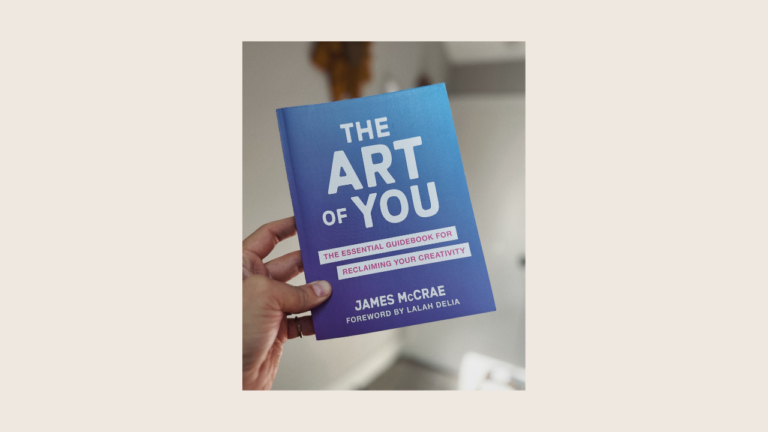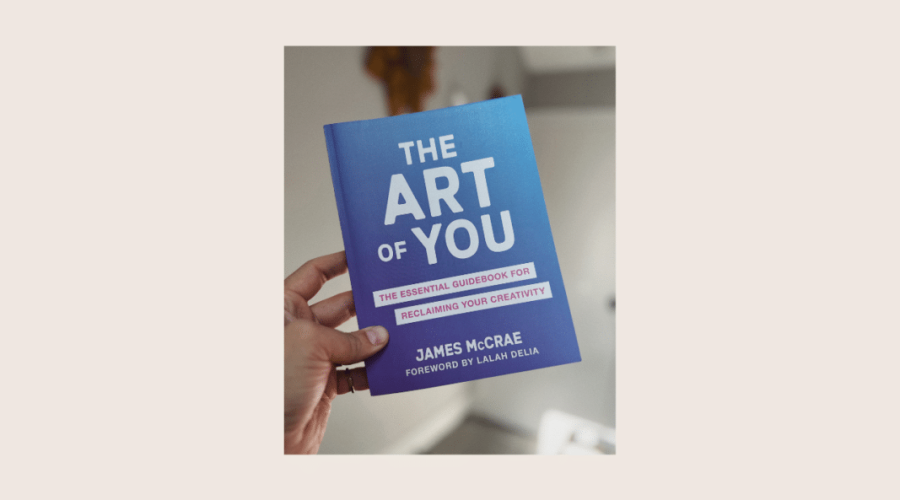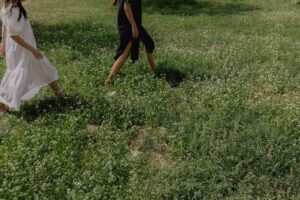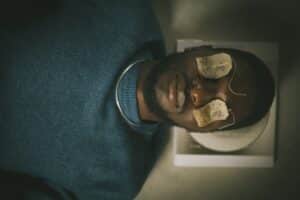We’re thrilled to offer you an exclusive sneak peek into “The Art of You” by James McCrae, the talented author and creative visionary behind the Instagram account “Words are Vibrations“.
In this preview, McCrae explores the intricate link between creativity and emotion, delving into the depths of personal growth and self-discovery. Through his unique perspective, McCrae offers invaluable insights that can inspire readers and make them feel stronger, encouraging them to express themselves creatively and discover their true abilities.
Creativity and Emotion: A Love Story
“A work of art which did not begin in emotion is not art.” – Paul Cezanne
Emotion is the underlying energy that fuels creativity. Before we can make something, we must have an idea. And before we can have an idea, we must have a feeling. Feeling comes before thought. Therefore, listening to and processing our emotions are essential parts of the creative process.
Like a deep exhale, art offers a cathartic release, both to the creator and the receiver. It can inspire awe, curiosity, hope, love, and excitement. Or it is an empathetic medicine that soothes our pain. Emotions are invisible and often hard to define, but art helps us to navigate and understand the inner world of felt sensation.
The creative process is a safe space to explore and express all emotions. No feeling is taboo. No pain or vulnerability is too naked. It’s about being honest with yourself and paying attention to what your body is telling you, then using your art to give form to the emotion, setting it free from the body’s memory.
All emotions are valid
Art exists within every facet of society. Happy people make art. So do sad people. Human creativity can be used to express a wide range of emotions and ideas, from the sacred to the profane and everything in between. Art can shock and provoke. It can inspire awe and wonder. It can fuel anger that sparks social change. It can make us cry tears of sadness and joy.
The paintings of Vincent van Gogh express an intense pathos and moody melancholy. The literature of Franz Kafka elicits a sense of dark introspection and paranoia. The music of The Beatles inspires feelings of love and universal connection. The speeches of Malcolm X express sacred rage toward social injustice. The writing of Sylvia Plath portrays a good-natured woman struggling with isolation and depression. All types of art—just like all emotions—are valid because they are honest reflections of the creator’s personal experience.
When we feel sad, there is comfort in listening to sad music because it reminds us that we are not alone. It’s okay to feel how we feel. In fact, it is essential to our well-being to allow ourselves to feel our feelings without resistance or bypassing. Feeling emotions is how we process them. When we fail to feel or process our emotions, they fester beneath the surface and emerge in unexpected forms such as hate or resentment, or they will decay into sickness. We must feel in order to heal.
The full spectrum of emotions
In his book Power vs. Force, David R. Hawkins charted the spectrum of human emotion from the highest frequency (most expansive) to the lowest frequency (most contracted). Here are Hawkins’s conclusions:
1. Enlightenment
2. Peace
3. Joy
4. Love
5. Reason
6. Acceptance
7. Willingness
8. Neutrality
9. Courage
10. Pride
11. Anger
12. Desire
13. Fear
14. Grief
15. Apathy
16. Guilt
17. Shame
We all aspire to be toward the top of this list, and I believe this is achievable for every human being. But sometimes life has other plans. We can’t always choose our environments, especially when we are young. Many of us are born into situations that inflict deep trauma on the psyche and heart. Therefore, if we find ourselves in a state of anger, shame, or fear, it is not indicative of a character flaw. It is a response to our environment. All emotions are valid and have something to teach us.
For example, anger may be perceived as a “negative” emotion, but for someone living in a state of shame or apathy, anger is a way to reclaim the power they have lost. The punk-rock music from the late 1970s used anger as a tool to escape apathy and express frustration toward social conformity and government corruption. Similarly, hip-hop music is often criticized as a shallow celebration of wealth and material excess. This criticism fails to account for the impoverished background of many of the artists. When someone is coming from a place of desire or anger, pride is a positive step toward self-worth and personal sovereignty.
It’s best not to wallow in contracting, low vibrational emotions. But on the journey to self-actualization, both as humans and creators, we need to be honest about our feelings. We can’t automatically jump from shame to joy, bypassing all the steps in between. Our emotions must be felt and processed before we can advance to the next stage. Art is an outlet to feel, understand, express, and transmute these emotions.
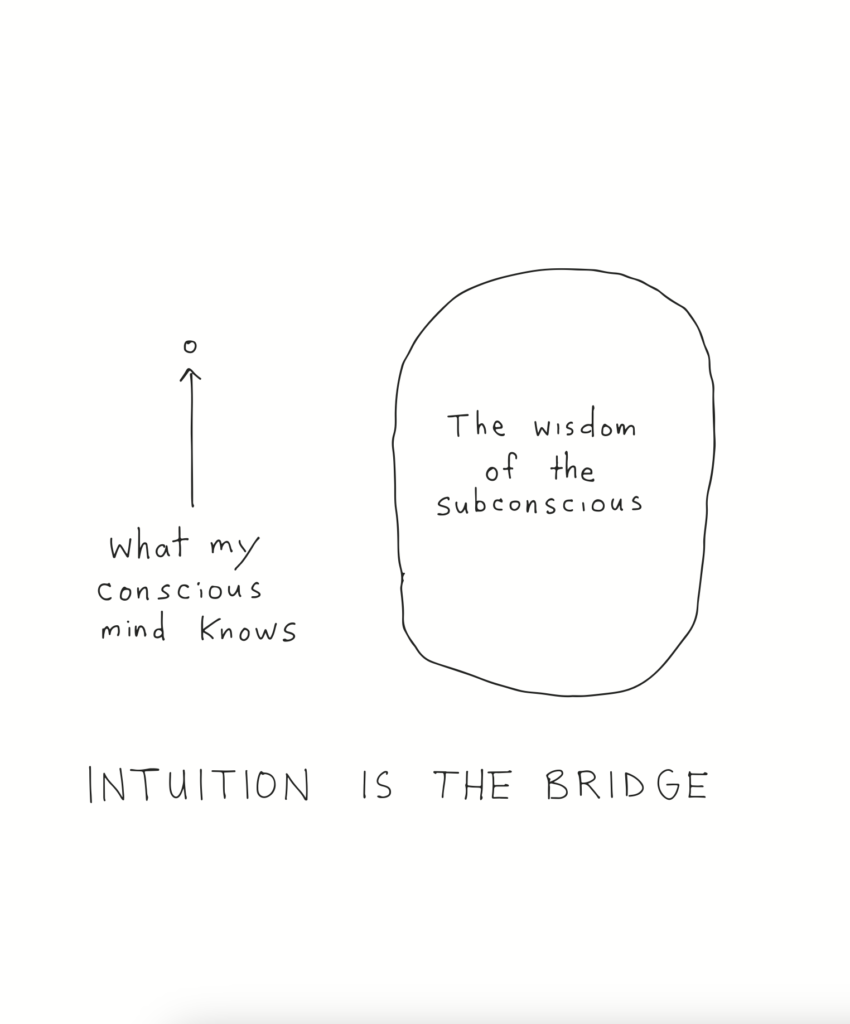
Creativity as a healing modality
In the middle of 2020, Los Angeles was in a state of emergency. Citywide lockdowns from the COVID-19 pandemic had led to vacant streets and bankrupt businesses. Black Lives Matter protests following the tragic death of George Floyd had devastated the city. The buildings on Abbot Kinney Boulevard were boarded up to protect them from looters. The National Guard was deployed. Military vehicles and sol- diers with machine guns were stationed along Hollywood Boulevard. Economic depression had accelerated the already prevalent homelessness crisis, and communities of tents had taken over the sidewalks near Venice Boardwalk. To make matters worse, it was fire season. The sky across the entire West Coast was tinted orange from smoke. More than once we were forced to evacuate our home in Topanga Canyon because of looming wildfire threats.
Such was the state of the city when my partner and I decided to leave Los Angeles and move to Austin, Texas. The choice of Austin was arbitrary — neither of us had ever been to the city before. We didn’t have any friends there. Yet intuition told us the move was the right decision. Ready for a new adventure, we packed our bags, said goodbye to Los Angeles, and drove 1,300 miles through the western desert to our new Texas home.
Austin, we learned, has long been a hub for creative expression. For decades, misfit artists and musicians have traveled across the country to call the city home. “Keep Austin weird” is the city’s motto. The welcoming, open-minded nature of the community encourages honest, authentic expression, as exemplified by local artists like Janis Joplin and Daniel Johnston. It’s been said that a nearby landmark called Enchanted Rock—considered a sacred site by the Indigenous Comanche people— is an energy center that helps to heal and unlock the throat chakra, allowing people to express themselves more fully and clearly.
Perhaps no artist better represents the spirit of Austin than country singer Willie Nelson. After spending many years in Nashville as a clean-cut professional songwriter, Willie had achieved modest success writing songs for others, but he failed to break through as a solo performer. The Nashville sound was too polished, too pretty. It was an awkward fit for Willie, a rough-around-the-edges Texas native. He wore a big smile on his clean-shaven face, but under the surface his soul was suffocating.
Finally, he couldn’t take it anymore. Willie left Nashville and bought a horse ranch in Texas, where he began performing at small honky- tonk bars in Austin. Free from the commercial restraints of Nashville, he could finally express himself fully. He grew a beard and ponytail, wrapped a bandana around his head, and started smoking copious amounts of cannabis. He developed his own unique style of music that infused country, pop, blues, and jazz. It sounded nothing like the polished Nashville sound. Crowds loved it. This new style came to be known as “outlaw country.” Willie Nelson, against all odds, became one of the most successful and beloved country music artists of all time.
• • •
Shortly after we arrived in Austin, the COVID-19 restrictions in Texas began to lift. Businesses reopened and crowds were allowed to gather in public. After nearly a year in quarantine, it was a much-needed exhale. I was ready to stop interacting with people exclusively through computer screens and make some real human connections in my new community.
I launched a monthly open-mic night and creativity gathering called Sunflower Club. The idea behind the name is that sunflowers will twist their faces toward sunlight in order to feel the light and warmth. Artists, I believe, do this too. We turn our faces toward the light, toward beauty, toward art wherever we can find it. The sunflower is, in my opinion, a symbol for art and creativity of all kinds.
Each month our club gathered to express ourselves in the form of poetry, storytelling, and song. Men and women of all ages—many who had never performed in public before—expressed their most intimate thoughts and feelings: a confessional about cheating on a husband, the feeling of depression and isolation during quarantine, a song sung as a love letter to someone’s younger self. One woman recited a poem written by her high school boyfriend before he committed suicide twenty years earlier.
After a year of lockdown, it was like the floodgates had opened and our emotions could flow again. We listened together, laughed together, and cried together. It was refreshing and cathartic, both for the perform- ers and the audience. I realized that nearly everyone I know is a writer in their private life, recording reflections in notebooks that perhaps nobody will ever read. Being given a forum to express our creativity in public—to be seen and heard without judgment—was an experience of emotional healing.
(Since launching, Sunflower Club has grown into a global decentralized creative community, with branches sprouting up all over the world. Sunflower Club is an open forum for people to express their innate creativity. All modes of expression are welcome, from poetry to music to dance to storytelling. If you’re interested in hosting a Sunflower Club in your community, visit jamesmccrae.com to learn how.)
One of the first friends I made in Austin was a poet and singer named Emma Zeck, who taught me much about creativity as a modality for processing emotion and healing trauma. Like so many people, Emma grew up in a tumultuous environment where it was unsafe to speak openly and express herself. The pains we experience in childhood, when not properly processed, tend to be suppressed deep within the body, leading to emotional and physical complications. Healing our unresolved trauma is important to our well-being, both as individuals and a society.
Through her poems and songs, Emma uses creativity to explore and release her deepest emotions, including pain, heartbreak, joy, lust, worship, and self-love. No topic or feeling is off limits. Listening to Emma perform is like watching a bird escape its cage and fly toward the sun, finally liberated.
Because we are friends, I usually know what Emma is going through, whether it’s falling in love, a breakup, or a period of quiet reflection. And when I see her perform, it’s all there, laid out naked for the world to see. Her expression is cathartic, both for Emma and the audience. And her courageous vulnerability gives others permission to excavate and release their own emotions—both the good and the bad—through art.
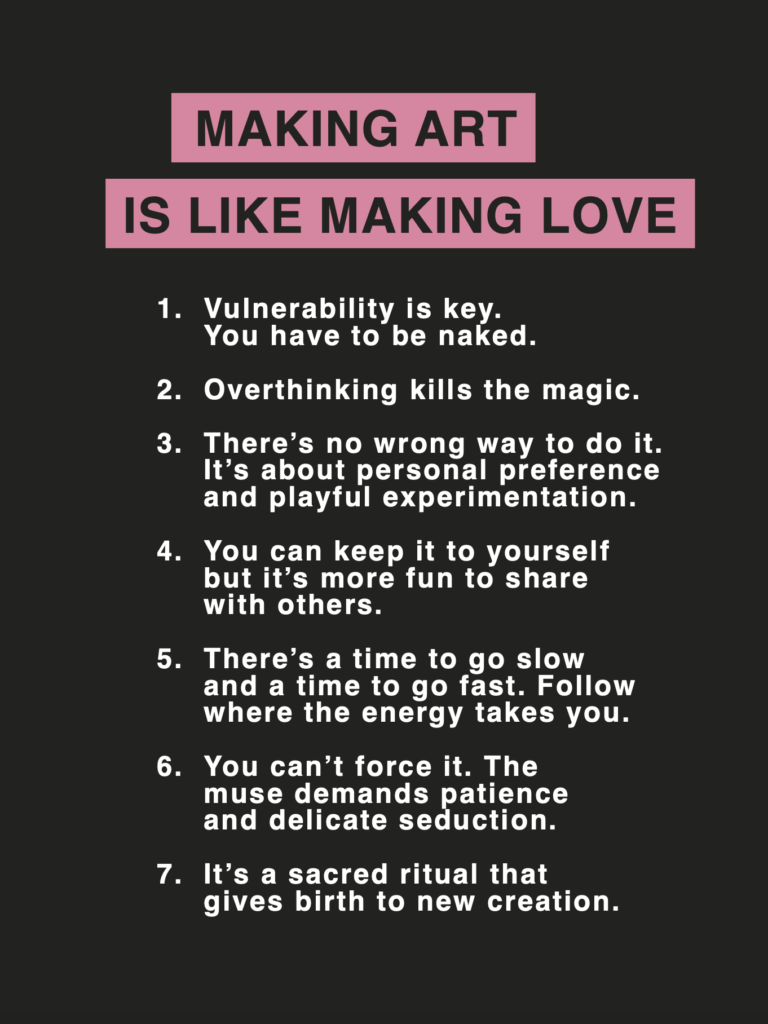
Sensitivity is a superpower
Around the turn of the twentieth century, coal miners brought caged canaries into work sites. The mines emitted dangerous gases, including carbon monoxide. The canary would be affected by the gas before the humans. If the canary died, the miners knew it was time to leave. The canary served as an early warning.
Creatives are the canaries in the coal mine of society. No, we don’t die from dangerous gases, but creative people, being sensitive by nature, feel things before others. The changing mood of the collective is first picked up by the artist’s antenna and communicated through creative expression.
In 1964, when Bob Dylan released his prophetic anthem, “The Times They Are a-Changin’,” he was ringing a bell to alert the world of the massive cultural shifts that would soon take place. He could see these changes coming because he had already felt them inside himself.
The fiction of Octavia E. Butler was also visionary. In her 1993 novel Parable of the Sower, she portrays the post-apocalyptic aftermath of a global pandemic, which alters the fabric of society. The deep feelings of isolation and uncertainty felt altogether too real and immediate as I read the book during the 2020 pandemic. Butler possessed an attuned emotional awareness that allowed her to tap into the collective mood thirty years in the future.
Artists have many important social roles. We provide beauty, entertainment, inspiration, education, and spiritual insight. One overlooked role is that of visionary and prophet. Being a prophet does not necessarily mean knowing the future. It means knowing yourself and your own emotions. On some level, we are all connected. The winds that blow through society touch us all. When we tune into our own emotions, we also tune into the changing winds of culture. Sensitivity is a superpower. The deeper we feel inside ourselves, the further we see outside ourselves.
Transmuting emotion into art
The mind and body are not in opposition. They are intimately connected. In fact, our emotions are often the unseen motivating force behind our thoughts. We think something because we feel it first. As such, it’s important for creatives to be in touch with our bodies and feelings. Creativity that is informed by emotional sensitivity will be richer, deeper, and more relatable than creativity guided by intelligence alone. Emotion is the glue that binds us together as humans.
Depending on our life experiences, different people will have different thoughts, but the common language of fear, heartbreak, anger, love, hope, and joy is shared by all. When we tap into our emotions to fuel our art, we are tapping into the collective emotional body. If I am feeling a certain way, there’s a good chance that millions of others are feeling something similar. Our reasons may be different, but the feeling connects us.
I have traveled all around the world, but the most important journey I have ever taken — both as a human and an artist — is the eighteen inches between my head and my heart. The body has an intelligence that surpasses the intelligence of the mind. Much of what we think, whether we realize it or not, is based on how we feel. Being in touch with our body and emotions gives us a deeper understanding of our- selves and the world around us.
My creative process often begins with me sitting down in a comfortable position and checking in with my body. How am I feeling? What are my emotions trying to tell me? If I’m feeling angry, where is that showing up in my body? Is my chest tight? Is my stomach clenched? When we are guided by emotions instead of only thought, we are closer to the source of creative energy. The ideas we generate will be more clear and impactful because they’re rooted in the body’s intelligence.
Creative expression is a healing modality. Like therapy, it moves emotional energy into the mind’s awareness so it can be released by the body. Emotions are not only valid, they are essential. They contain wisdom and intelligence in the form of felt presence. Pay attention to your body. Listen to your feelings. Take your pain, your sadness, your hope, your love, your loneliness, your existential dread, and transmute them into art.
Grab your copy of The Art of You: The Essential Guidebook for Reclaiming Your Creativity here.


